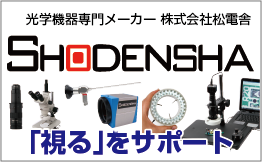Visual inspection from microscope to microscope
I think the use of microscopes for inspections in inspection lines and similar settings is quite common. Inspections with microscopes can be very tiring, placing a significant burden on inspectors. That’s why many people are considering replacing microscopes with magnifying scopes. However, there are also many types of magnifying scopes, and choosing the right one is crucial to avoid adding unnecessary strain. There are three key points to consider when switching from microscopes to magnifying scopes.
Three important points for replacement
①Choose a model with a high frame rate
The magnifying scope displays images on a PC or monitor. If the frame rate is low, the displayed images won’t move smoothly, causing additional stress. Frame rate is expressed as a numerical value, and the optimal range where people don’t feel discomfort is around 50 to 60 frames per second (fps). Below 30 fps, discomfort becomes more noticeable. Models that can be connected to a PC often suffer from low frame rates due to USB communication speed issues. Therefore, it’s recommended to choose a model that can be directly connected to a monitor.
②Choose a model with good color reproduction
The appearance through the camera used in the magnifying scope can vary. Consequently, there are cameras with excellent color reproduction and those with less impressive performance in this regard. When colors are not accurately represented, it can cause discomfort and stress as our brains perceive discrepancies. Even a slight shift, like red appearing slightly orange, can induce stress. Opting for a Full HD camera can provide relatively high color reproduction accuracy, resulting in clear and vivid images.
③Choose a model with a wide dynamic range
You might not often hear the term “dynamic range,” but I’ll explain it simply. It refers to the ability to capture both bright and dark areas simultaneously without overexposing or underexposing either. When adjusting brightness for one, the other may become washed out or too dark.
To overcome this, a camera with a wide dynamic range is necessary. Dynamic range is a characteristic of cameras, and it varies between different models. Compared to typical cameras, the human eye is remarkably adept, with a wide dynamic range.
Many discrepancies between what we see with our eyes and what is captured by a camera can be attributed to differences in dynamic range. Some models highlight their wide dynamic range capabilities, so choosing such models would be optimal.
The recommended model
It sounds like your company offers a model that meets all three criteria mentioned. The Full HD microscope with a frame rate of 60fps ensures smooth viewing, while the color reproduction is exceptionally clear due to the Full HD resolution. Additionally, the model features HDR (High Dynamic Range) functionality, providing a wide dynamic range to capture both bright and dark areas effectively.
With demo units available, I encourage you to give it a try. It seems like an excellent opportunity to experience the capabilities of the microscope firsthand.



